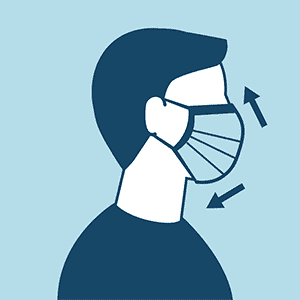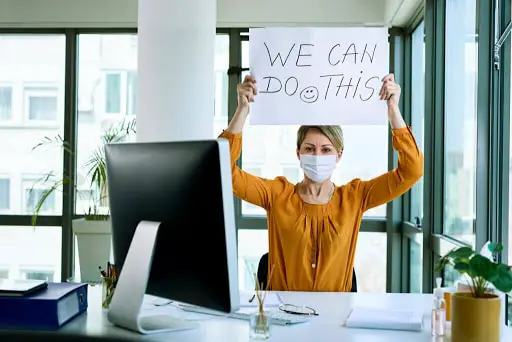Unfortunately, the world is still in the grips of a global pandemic. However, as we have proved countless times before, life goes on. There are some things that you should keep in mind, though, if you’re considering returning to the office despite the health risk.
How to Maintain Social Distancing in Common Areas
If there are three rules to live by during this pandemic, here they are: first, don’t go outside unless it’s absolutely essential; second, wear proper protective gear like face masks and plastic shields; and third, keep your distance. The World Health Organization recommends keeping at least a meter apart from other people.
recommends keeping at least a meter apart from other people.
Crowded Elevators
While it is always ideal to opt for the stairs, pandemic or not, we recognize that this is not always possible, especially if your office is located dozens of floors above.
If it really can’t be avoided, just make sure to follow the floor markings if available. If not, then just be responsible enough to still practice the proper social distancing protocols.
Sharing Public Facilities
The same applies when you’re in public facilities and common areas. We also recommend avoiding touching any surfaces that are heavily exposed to handling such as handles, light switches, remote controls, and more.
If it really can’t be avoided, then simply disinfect your hands before and after use. Why before, you ask? This is to prevent others from getting sick just in case you’re asymptomatic and unaware of your infection.
Open Office Plans
Open workspaces inspire creativity and collaboration. Sadly, it also puts workers at more risk in the presence of an infectious disease like COVID-19. There are a few ways to mitigate the health consequences, though.
Areas, where people tend to bottle-neck or congregate, must be noted and avoided.
You can also consider installing a barrier that separates your cubicle from others if you’re working on a shared work surface.
Finally, encourage your colleagues to collaborate digitally instead. There are various online platforms that allow people to create mind maps, flow charts, and accomplish other collaborative work remotely.
How to Clean the Office
Employers definitely have more control over the cleanliness of your work environment. However, there are still ways we can do as employees to keep our office a safer place to work in.
How to Clean the Personal Workspace
It all begins by keeping your own workstation clean. Keep disinfecting wipes handy and use them as needed. Don’t reuse your wipes. Dispose of it immediately after using it on anything.
and use them as needed. Don’t reuse your wipes. Dispose of it immediately after using it on anything.
Avoid lending your office supplies to other people as well. This includes commonly handled items like your phone, pen, and computer peripherals.
Cleaning Public Areas
As for public areas, the best you can do is to practice common courtesy. Don’t litter, especially if you’re throwing away potentially infected items like your used disinfecting wipes.
Employers, on the other hand, must develop a strict sanitation protocol daily. According to the National Institutes of Health, there is scientific evidence that the novel coronavirus can stay alive and active on a surface for days.
Hence, the more frequent public areas are cleaned, the safer people will be.
How to Use Sharing Facilities
As mentioned, it’s always best to avoid shared facilities as much as possible, but you can’t always do that. Hence, here are some tips on how to use common areas at work.
Bathrooms
Limit bathroom trips. Keep a disinfecting spray handy and be ready to spritz before you enter a cubicle. Perform your personal business as fast as you can. Exit immediately after flushing. Don’t linger around. Wash your hands with soap and water. Finally, skip the dryer. Opt for paper towels instead.
Kitchens
The biggest enemy in common pantries and kitchens is handles. Just think about how many hands hold coffee maker and fridge handles per day?
Be mindful of where you place your food as well. Not all surfaces are safe despite looking clean.
In the end, it’s best to put matters into your own hands and disinfect the things and surfaces that you are going to use. Doing so after you’ve used them, on the other hand, is always polite for the next user.
Finally, keep your drinking gear covered. Don’t leave your straw or your wide-mouthed mug exposed.
Conference Rooms
Again, using online platforms instead of actual conference rooms during meetings is better. However, if you are required to attend one onsite, then adhere to the floor and seat markings enforced by the company.
Stay at least a seat apart from other people in the absence of markings. And don’t forget, you can always politely refuse to enter a crowded conference room during this health crisis.
Hallways
Find a less populated route whenever possible, or avoid passing through hallways during peak hours like break times.
Employers can also opt to create one-way schemes to further bring down foot traffic. Just make sure to make your employees aware of the updated plan before implementation.
Arrow markings to determine the route of a hallway are also a must to avoid confusion.
Rearranging the Working Space
Work cubicles must be rearranged, following the social distancing guidelines. While employees have limited control over this, here are some tips that business owners can apply for a healthier work environment despite the pandemic:
• Limit occupancy. If rearranging cubicles are simply not possible due to limited space, then another efficient way to keep employees apart is to limit the occupancy of your work floor every shift. Each cubicle must also be sanitized before the switch to avoid cross-contamination.
• Remove reception and waiting areas. Visitors must be discouraged due to the current circumstances anyway.
• Install sanitation stations. Don’t forget to check them frequently to make sure that their disinfecting supplies never run out.
• Finally, widen up hallways. As mentioned above, hallways tend to get populated during specific hours of the day. Rotating shifts and breaks can help lessen heavy foot traffic. However, you can also widen up hallways by removing any unnecessary furniture and decorative elements that occupy floor space.
Is Wearing a Mask All Day a Requirement?

Lastly, here’s a question we commonly get from our readers. Honestly, the answer depends on two things: your current health condition and the nature of your work.
Those who will be working in an enclosed working environment (like office work) are strongly urged to wear a mask. There are companies that strictly enforce this practice as well, so there is a possibility that you won’t be able to enter your building if you’ve forgotten your mask at home.
On the other hand, those who work outdoors may be exempted from wearing masks if:
• it will increase the risk of heat-related illness;
• It can hinder the use of equipment or heavy machinery;
• your job requires strenuous physical activity that can make it harder for you to breathe.
Speaking of breathing difficulties, those who have related health issues are also not required to wear a mask, such as those who suffer from asthma or cardiorespiratory ailments.
Those who have physical challenges, such as deaf people who rely on lipreading to communicate, are not exempted, though. Instead, they are encouraged to use writing mediums to converse.
Anyway, here are a few more mask-related tips:
1. Just use it. There’s still a lot of controversy surrounding the efficiency of mask usage. We understand that there are people who disapprove of it for various reasons.
However, the Centers for Disease Control and Prevention (CDC) strongly recommend it in order to prevent asymptomatic people from infecting others.
Face masks serve as an initial barrier from releasing respiratory droplets that might contaminate other people, things, surfaces, and even air itself.
2. Don’t forget to replace them frequently. Using disposable masks are always ideal since they are easy to replace after a few hours of use.
Those who are constantly exposed to high-risk areas are even encouraged to switch face masks more frequently.
3. Wash your reusable face masks properly. There are ways to sanitize reusable face masks. Just be mindful of how you handle used ones to prevent cross-contamination.
4. What about face shields? The CDC discourages the use of face shields to replace face masks. However, they can be used as supplementary protective equipment together with your mask to further block respiratory droplets from reaching your face.
discourages the use of face shields to replace face masks. However, they can be used as supplementary protective equipment together with your mask to further block respiratory droplets from reaching your face.
5. Disinfection is still key. Lastly, don’t allow face mask usage to give you a false sense of protection. Keeping your hands clean at all times and avoiding touching your face randomly while practicing social distancing are still the best ways to protect yourself from getting sick.
Sum up
There will always be considerable health risks should you plan to go back to work onsite during the pandemic. However, there are steps that can significantly decrease the likelihood of getting sick, or worse, bringing the infection home.
By practicing the tips that we have shared with you above, we hope that you will be able to return to work with less worry for both your physical and mental well-being. After all, we must not let this crisis defeat us.

